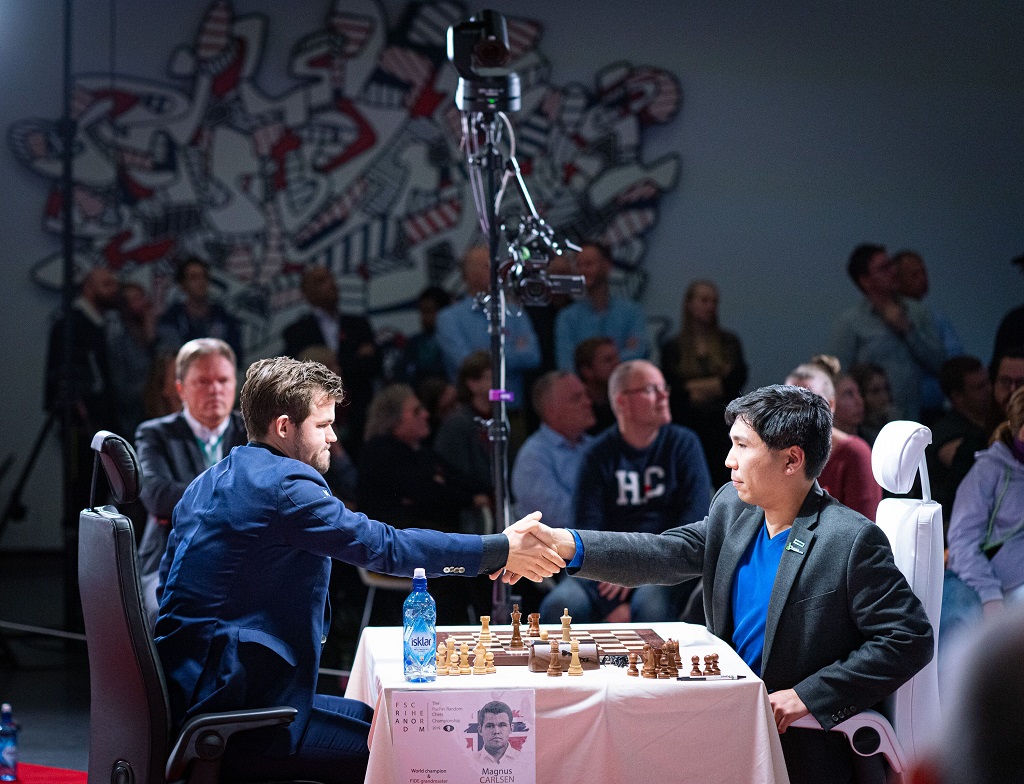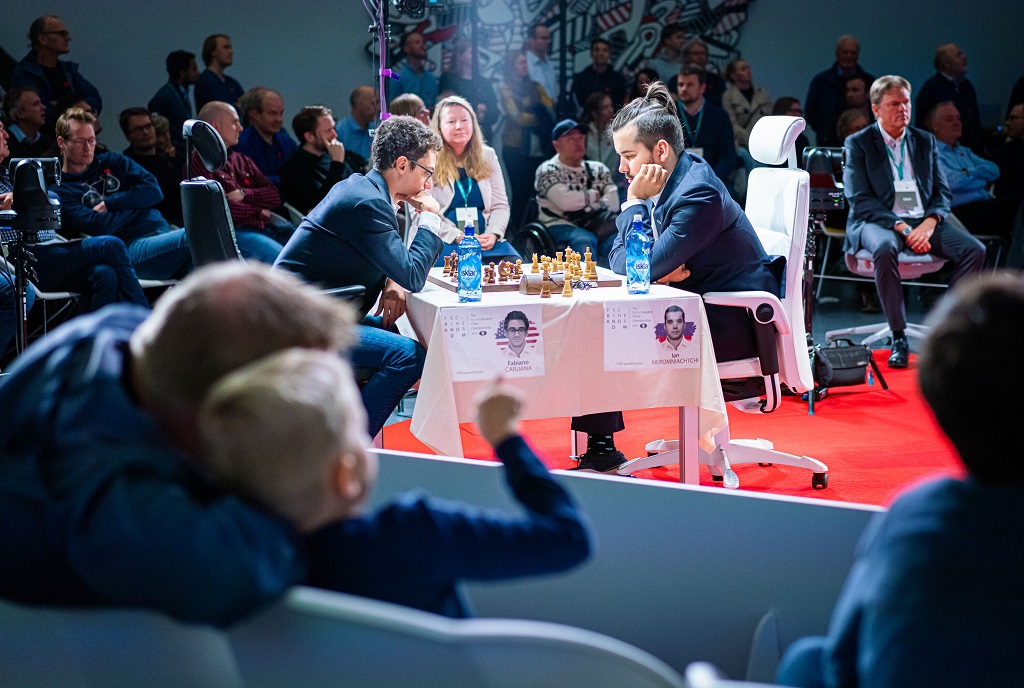


The second drawn position of the finals was not as similar to the normal setup as the first one was, except for the fact that the rooks were placed on the a and h-files. The bishops were strangely sitting on the central files, while the king from b1 (or b8) would need to move no fewer than five squares in order to castle short.
Wesley So later noted that 1.e4 is clearly the best move, as Black needs to "fight hard to equalize" after Fischer's favourite opening pawn push. The American started the day with White and saw his opponent going for a French Defence structure. In this setup, however, after 1.e4 e6 2.d4 d5 3.e5 the usual 3...c5, played by Carlsen, is not as sound as in the normal French, as White gets to capture and attack the queen — 4.dxc5 ♛xc5 5.♘b3 — gaining an edge in development.
Apparently the world champion was in a fighting mood though, eager to recover from his loss in game two. Unfortunately for him, however, So has been playing fantastic chess in this event. The American played accurate positional chess to get ahead after the opening. His play was not perfect, but he was clearly the one calling the shots.
In the last move before the time control, Carlsen, who had been defending tenaciously for quite a while, took a step in the wrong direction:
Black's best alternative here was to capture on g2 with the rook, but apparently Carlsen did not want to go into the rook endgame that would ensue after 40...♜xg2 41.♘xf5 exf5 — the computers give White and edge in this line, but as usual a lot of precision would be needed to convert such ending. Instead, after 40...♞xh4 White patiently found the way to gobble up the e and f-pawns, using well-timed checks with his rook and knight.
In the end, So had two connected passers against Black's single passed pawn on the other flank of the board — a configuration that would reappear in the next encounter:
Carlsen resigned after 60.b5+.

The moment Carlsen resigned game three of the final | Photo: Lennart Ootes / frchess.com
The world champion was trailing by six points. Would he try to cut the losses and play a cool game relying on his superiority in faster time controls? Or would he go all-in to bridge the gap immediately?
Carlsen chose the latter, and resoundingly so, as he opened his white game with 1.a4, 2.a5, 3.a6, once again allowing his opponent to get the upper hand strategically simply by responding with sound positional moves. At some point, So got chances to create an attack against White's king, but the American decided to trade queens instead, going into a superior endgame. And, for a second time in a row, his queenside passers were the decisive factor:
A b-pawn push was again the final move — 50...b3 and White resigned.

Wesley So seems to be getting along pretty well with the Norwegian fans | Photo: Lennart Ootes / frchess.com
Thus, So will go into the final day of action with a nine-point lead, needing only two points to secure victory — a win in the first 'fast rapid' game would be enough. Of course, to see Carlsen losing three games in a row is not a common sight, especially in slow time controls: the world champion has not lost a classical game of chess since July 2018! Needless to say, he did not leave the playing hall in a good mood, rejecting to speak with the Norwegian press for a second day in a row, as Tarjei J. Svensen reported.
Commentator Danny Rensch and Wesley So commented:
Rensch: He doesn't like to lose two in a row.
So: He doesn't like to lose at all...even in basketball or soccer.
Fabiano Caruana was in the studio when So got the second victory of the day, and explained:
Everyone has bad days, including Magnus, and one bad day in this event is kind of the end. You usually don't get another chance.

Time for an epic comeback? — Magnus Carlsen | Photo: Lennart Ootes / frchess.com
Caruana, in the match for third place, did not take the drastic approach Magnus took after losing the first game of the day, as he did not over-push with White and finished the day with a draw, which means he is trailing Nepomniachtchi by three points before the deciding quick-play rounds. Nepomniachtchi got a fine 48-move victory in his game with White, exchanging down into a winning endgame after having successfully dealt with Caruana's threats during the middlegame. The final position:
The match for third place might be the first one of the event to reach the blitz stage, as long as Caruana gets off on the right foot on Saturday.

Fabiano Caruana and Ian Nepomniachtchi | Photo: Lennart Ootes / frchess.com
Download the PGN files of the games and examine them in ChessBase: Day 1, Day 2.
| Rank | Name | Score | Rating |
|---|---|---|---|
| 1 | So, Wesley | 10½/12 | 2767 |
| 2 | Carlsen, Magnus | 1½/12 | 2876 |
| Rank | Name | Score | Rating |
|---|---|---|---|
| 1 | Nepomniachtchi, Ian | 7½/12 | 2776 |
| 2 | Caruana, Fabiano | 4½/12 | 2812 |
Commentary by Sopiko Guramishvili, Danny Rensch and Yasser Seirawan
| Advertising |